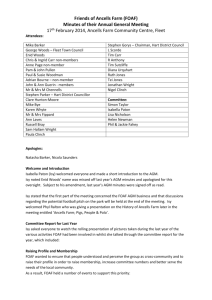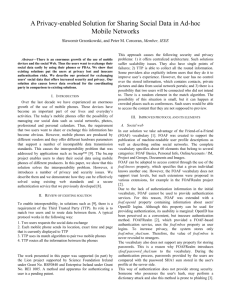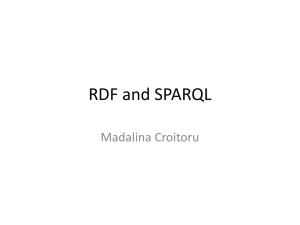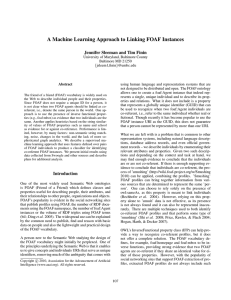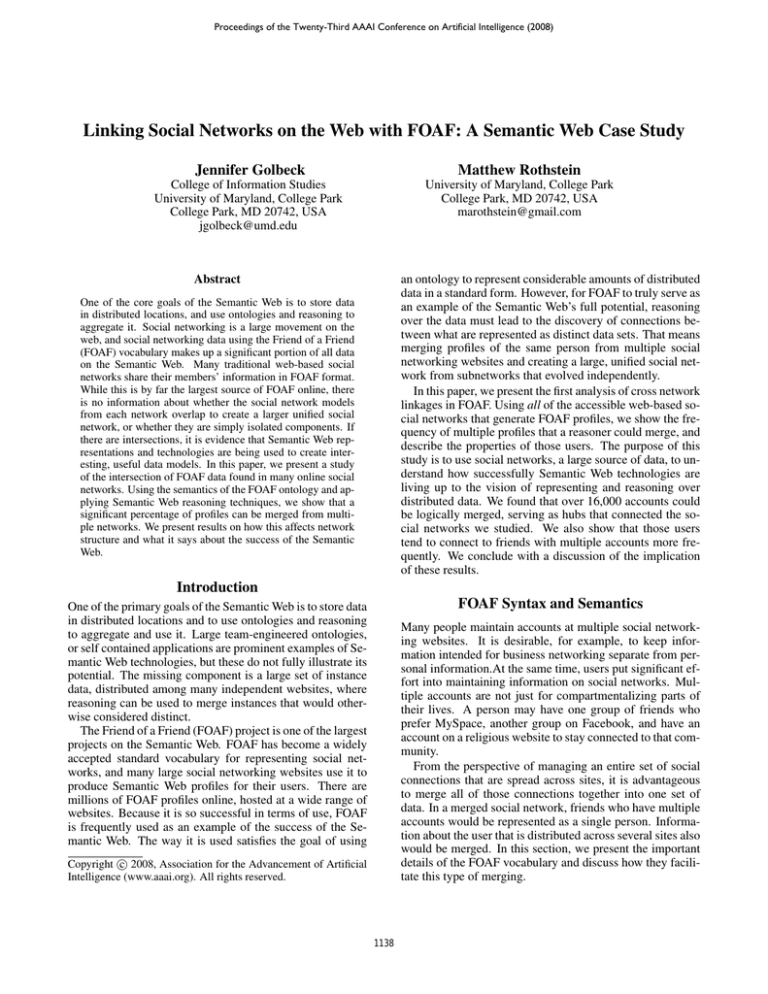
Proceedings of the Twenty-Third AAAI Conference on Artificial Intelligence (2008)
Linking Social Networks on the Web with FOAF: A Semantic Web Case Study
Jennifer Golbeck
Matthew Rothstein
College of Information Studies
University of Maryland, College Park
College Park, MD 20742, USA
jgolbeck@umd.edu
University of Maryland, College Park
College Park, MD 20742, USA
marothstein@gmail.com
Abstract
an ontology to represent considerable amounts of distributed
data in a standard form. However, for FOAF to truly serve as
an example of the Semantic Web’s full potential, reasoning
over the data must lead to the discovery of connections between what are represented as distinct data sets. That means
merging profiles of the same person from multiple social
networking websites and creating a large, unified social network from subnetworks that evolved independently.
In this paper, we present the first analysis of cross network
linkages in FOAF. Using all of the accessible web-based social networks that generate FOAF profiles, we show the frequency of multiple profiles that a reasoner could merge, and
describe the properties of those users. The purpose of this
study is to use social networks, a large source of data, to understand how successfully Semantic Web technologies are
living up to the vision of representing and reasoning over
distributed data. We found that over 16,000 accounts could
be logically merged, serving as hubs that connected the social networks we studied. We also show that those users
tend to connect to friends with multiple accounts more frequently. We conclude with a discussion of the implication
of these results.
One of the core goals of the Semantic Web is to store data
in distributed locations, and use ontologies and reasoning to
aggregate it. Social networking is a large movement on the
web, and social networking data using the Friend of a Friend
(FOAF) vocabulary makes up a significant portion of all data
on the Semantic Web. Many traditional web-based social
networks share their members’ information in FOAF format.
While this is by far the largest source of FOAF online, there
is no information about whether the social network models
from each network overlap to create a larger unified social
network, or whether they are simply isolated components. If
there are intersections, it is evidence that Semantic Web representations and technologies are being used to create interesting, useful data models. In this paper, we present a study
of the intersection of FOAF data found in many online social
networks. Using the semantics of the FOAF ontology and applying Semantic Web reasoning techniques, we show that a
significant percentage of profiles can be merged from multiple networks. We present results on how this affects network
structure and what it says about the success of the Semantic
Web.
Introduction
FOAF Syntax and Semantics
One of the primary goals of the Semantic Web is to store data
in distributed locations and to use ontologies and reasoning
to aggregate and use it. Large team-engineered ontologies,
or self contained applications are prominent examples of Semantic Web technologies, but these do not fully illustrate its
potential. The missing component is a large set of instance
data, distributed among many independent websites, where
reasoning can be used to merge instances that would otherwise considered distinct.
The Friend of a Friend (FOAF) project is one of the largest
projects on the Semantic Web. FOAF has become a widely
accepted standard vocabulary for representing social networks, and many large social networking websites use it to
produce Semantic Web profiles for their users. There are
millions of FOAF profiles online, hosted at a wide range of
websites. Because it is so successful in terms of use, FOAF
is frequently used as an example of the success of the Semantic Web. The way it is used satisfies the goal of using
Many people maintain accounts at multiple social networking websites. It is desirable, for example, to keep information intended for business networking separate from personal information.At the same time, users put significant effort into maintaining information on social networks. Multiple accounts are not just for compartmentalizing parts of
their lives. A person may have one group of friends who
prefer MySpace, another group on Facebook, and have an
account on a religious website to stay connected to that community.
From the perspective of managing an entire set of social
connections that are spread across sites, it is advantageous
to merge all of those connections together into one set of
data. In a merged social network, friends who have multiple
accounts would be represented as a single person. Information about the user that is distributed across several sites also
would be merged. In this section, we present the important
details of the FOAF vocabulary and discuss how they facilitate this type of merging.
c 2008, Association for the Advancement of Artificial
Copyright Intelligence (www.aaai.org). All rights reserved.
1138
The Vocabulary
social relationships and personal information from networks
that do not generate FOAF, the scope of this work is to look
only at FOAF files produced by the networks.
There are 11 active social networking websites that output
FOAF files, with an approximate total of 13,120,000 members among them (see table 1). We used all of these networks in our research. LiveJournal is the largest of those,
accounting for just over 75% of the total estimated membership, with approximately 10,000,000 users. We included all
11 of these websites in our survey.
For each network, we gathered as many profiles as possible. Some networks - FilmTrust, Ecademy, and Advogato provided a full list of all of their members.In the rest of the
networks, a full list of members was not available, and thus
we had to crawl the network. Table 1 shows the number of
users in each network that we were able to use in this study.
While this is not the total membership of every network, we
believe that this serves as an accurate sample to illustrate
inter-network connectivity. Furthermore, any applications
using FOAF would need to follow the same procedures we
did in this study, and thus our data set is representative of
what FOAF applications would use.
Six of the eleven websites on this list are blogging websites based on the open-source LiveJournal code. FOAF output is built into LiveJournal, so it is automatically produced
when a website implements it. As such, blogging accounts
for a disproportionate percentage of our data. Overall, blogging websites account for 19 of the 226 (or 8.4%) known
social networks, and only 2.7% of the total membership. In
this study, six of the 11 websites are for blogging (54.5%),
and they make up 23.1% of the membership we studied. Evidence siggests that social networking behavior on blogging
websites may be quite different from behavior on “pure”
social networking sites with no external purposes (Golbeck
2007). Thus, if FOAF were available on a more representative set of social networking websites, the results of a study
like this may be different.
Rather than a website or a software package, FOAF is a
framework for representing information about people and
their social connections. Written in OWL, FOAF contains
terms for describing personal information, membership in
groups, and social connections.
People are described as instances of the foaf:Person class.
There are many properties to describe attributes of people,
including name, email address, and documents they produce1 . The property foaf:knows is used to create social links
between people (i.e. one person knows another person).
Reasoning with FOAF
FOAF utilizes the semantics of the Web Ontology Language
OWL. While the overall idea is straightforward- describe attributes of people - FOAF utilizes several features of OWL
so interesting inferences can be made.
Inverse roles are used several times.This allows a reasoner
to infer some bi-directional relationships between instances
of FOAF classes.
For the work presented in this paper, the
most important semantic feature is the use of
owl:InverseFunctionalProperty.
An inverse functional
property connects an instance to a unique identifier. Unique
identifiers in FOAF are the following: foaf:aimChatID,
foaf:homepage, foaf:icqChatID, foaf:jabberID, foaf:mbox,
foaf:mbox sha1sum, foaf:msnChatID, foaf:weblog, and
foaf:yahooChatID. These properties are used as unique
identifiers because it is rare that two people will share the
same email address, chat account, or blog address.
Any time two instances of foaf:Person have identical values for an inverse functional property, an OWL reasoner will
infer that the instances represent the same person. This is
the critical inference used in merging profiles that represent
the same person. In this research, we are interested only in
merging profiles in this way. While there are other techniques for finding duplicate profiles (see the discussion below for a thorough treatment), our work is directed toward
using this problem to understand the state of the Semantic
Web.
When an OWL reasoner infers that two profiles represent
the same person, the inference is always logically correct.
However, it can be the case that the inference is incorrect in
the real world. For example, two people may share an email
address or a user may have a typo that makes their email the
same as someone else’s. This potential for error is possible
with every automated system, and short of having a human
personally interview each member to confirm they are, in
fact, the same person, there is no way to be 100% accurate.
Methodology
For every member we were able to include in the study, we
accessed their FOAF file. For the purpose of this work,
we were interested only in the member’s friends and unique
identifiers (given by the inverse functional properties). Thus,
to save space and increase efficiency, we implemented a
task-specific OWL reasoner that considers only the FOAF
inverse functional properties and foaf:knows property, and
ignores the rest of the data.
Traditionally, a reasoner would not keep track of the
sources of each axiom in the knowledge base. Since we are
specifically interested in how data is repeated in multiple
sources, we added a provenance tracking feature to our reasoner. This maintains a record of the document where each
axiom is asserted. With this data available, it is straightforward to identify on which and how many social networks a
member has accounts, as well as the sources for each friendship.
Data Sources and Methodology
Data Sources
We set out to understand how frequently user profiles from
multiple social networks can be merged using the semantics
of FOAF, and to understand the impact that has on the structure of the unified social network. While it is possible to get
1
See http://foaf-project.org for the full vocabulary
1139
Table 1: The social networks used in this study, including the average shortest path length pre and post-reasoning.
Network
Purpose
Members Studied Avg. Degree APL (Pre) APL(Post)
Advogato
Business
2,778
13.51
2.17
2.15
Buzznet
Photos
208,324
1.00
4.43
2.76
DeadJournal
Blogging
9,801
3.74
3.19
3.23
eCademy
Business
61,242
3.08
2.20
2.19
FilmTrust
Social/Entertainment
1,250
1.06
3.75
3.84
GreatestJournal Blogging
36,862
33.36
2.25
2.31
InsaneJournal
Blogging
1,410
13.36
3.19
3.26
LiveJournal
Blogging
3,563,267
8.38
2.85
2.83
Minilog.com
Blogging
119
1.63
3.66
3.66
Rossia.org
Blogging
4,180
9.65
2.33
2.36
Tribe
Social/Entertainment
218,694
9.93
2.74
2.69
Results
Account Statistics
Our results show that 8,047 of unique people we found had
accounts on multiple networks, with a total of 16,295 accounts among them. While the number of members who
have accounts on multiple networks is a small percentage of
everyone we found, it is typical of patterns identified in social networks. A small percentage of nodes serve as hubs
with high centrality that connect otherwise distinct parts of
the network. While most work looks at hubs connecting
communities within a single network, these hubs perform
the same function by connecting different social networks
in the unified FOAF network.
Of the 8,047 people with accounts on multiple social networking websites, the vast majority, 7,849 (97.5%), had accounts on only two websites. Of those, 5,473 (69.7%) had
one of their accounts on LiveJournal, and one account on
another network. This raises an interesting point about LiveJournal: it is the only one of the eleven networks we looked
at that did not require users to enter an email address. In
fact, only 8.8% of the LiveJournal users we found in this
study had a foaf:mbox or foaf:mbox sha1sum. It is not possible to link accounts with no mbox, since every other network used the mbox sha1sum as a unique identifier. If the
LiveJournal members with email addresses are representative, we can extrapolate that just over 62,000 LiveJournal
members in the population we found have accounts on other
networks, which would lead to a much higher network interlinking rate with 1.5% of all users on at least two networks.
A small change by LiveJournal requiring an email address so
that their users’ FOAF could be linked to other FOAF would
make a big difference in the connections between networks,
and ultimately toward taking advantage of what the Semantic Web has to offer.
After aggregating and reasoning over the FOAF data, we
were able to see connections between the different networks,
and to analyze how the reasoning connected accounts and
affected friendships.
Network Statistics
After reasoning over all the FOAF data, the distinct networks generated by each social networking website were
connected when a member on multiple sites was identified as
the same person. This happens when a foaf:Person is found
in both networks with the same value for one of the inverse
functional properties mentioned above.
Table 2 shows the networks that we were able to connect
directly because they had a member in common. While every network was not directly connected to every other, every
network had connections to at least four others. No network
was isolated and thus the unified social network had paths
connecting every network to every other. Note that LiveJournal, the largest network in this study, had members with
accounts on every other network we studied.
As an example of networks are linked through users with
accounts on multiple websites, consider the user shown in
Figure 1. This depicts an egocentric network around one
user who has accounts on four different social networking
websites: Buzznet, DeadJournal, GreatestJournal, and InsaneJournal. This user had one friend with accounts on three
of these networks, seven friends with accounts on two networks, and the remaining friends had accounts on only one
network. We can also see that the central user is has relationships in both Buzznet and GreatestJournal with one of
these friends who has two accounts.
Reasoning over the FOAF allowed us to perform analyses
beyond points of connection between networks. By merging
profiles that shared email addresses, the graph within each
subnetwork changed. It was common to find many accounts
sharing the same address within one website. Thus, after
reasoning, the network structure would change. This can be
seen in the change in the average shortest path length pre
and post-reasoning as shown in table 1.
Friendship Statistics
Members who had accounts on multiple networks serve as
hubs in our unified social network. Traditionally, hubs in
social networks have more friends than average. That turned
out to be the case for our network bridging members as well.
Users who have multiple accounts also tend to have more
friends with multiple accounts. On average, friends of people with one account had 1.01 accounts, while friends of
1140
x
320
x
58
1967
387
22
8
702
32
x
1
5
1
16
5
208
x
4
1
10
x
Tribe
Minilog.com
8
x
75
19
Rossia.org
x
929
85
1
LiveJournal
6
13
InsaneJournal
1
89
GreatestJournal
DeadJournal
1
53
x
FilmTrust
2
x
eCademy
x
Buzznet
Networks
Advogato
Buzznet
DeadJournal
eCademy
FilmTrust
GreatestJournal
InsaneJournal
LiveJournal
Rossia.org
Minilog.com
Tribe
Advogato
Table 2: This table shows the number of members shared by each pair of networks.
53
793
28
161
17
15
2357
8
3
x
members with accounts on multiple networks had an average
of 1.15 accounts. This difference is significant for p < 0.05
using a standard two-tailed t-test. To look at more specific
numbers, friends of people with two accounts had an average of 1.15 accounts, and friends of people with three accounts had an average of 1.17 accounts. An ANOVA shows
a significant difference within the population, and a standard
2-tailed t-test shows that friends of people with two accounts
had significantly more accounts than friends of people with
one. The same also holds true for friends of people with
three accounts vs. two accounts (for p < 0.05).
When both people in a pair of friends had multiple accounts, they were frequently friends on multiple networks.
We found 15.71% of these members were friends in more
than one network. On average, they were friends in 57.75%
of the networks where they were both members.
These results show that a small percentage of users have
multiple accounts, but they tend to be well connected with
friends who also have multiple accounts. This core group is
sufficient to serve as a bridge between multiple social networks and act as hubs in the aggregated FOAF network.
Implications, Discussion, and Related Work
Given a large unified FOAF social network where we have
been able to logically merge profiles that represent the same
person on different networks, opportunities for further analysis and applications become available.
Figure 1: An egocentric network built around an individual found in our study with accounts on four WBSNs. The
node labels indicate the first letter of the domain name of the
WBSN.
Network Analysis
First, there are other techniques for extracting social relationship information on the web besides relying on FOAF
data. Parsers, scrapers, and APIs can be used to access network data, and even to produce FOAF if that is desired.
Flink (Mika 2005) is a system that uses some of these approaches and others to extract, analyze (including merging),
and visualize social networks on the web. The Flink approach is completely compatible with this work, and if uni-
1141
Email filtering is another subject where social networks
can be used. Both (Boykin & Roychowdhury 2004) and
TrustMail (Golbeck & Hendler 2004) use social networks
to filter messages. A unified FOAF network, where most
users are identified by email address, would provide a much
richer set of social information.
Another interesting application of FOAF has been for detecting conflicts of interest (Aleman-Meza et al. 2006).
When assigning reviewers to scientific papers, reviewers
have to self report potential conflicts. For many people, this
is potentially a long list. The authors present a technique for
using co-authorship from DBLP and the FOAF knows relationship to automatically identify conflicts of interest, and
describe how their work is applicable more generally to Semantic Web engineering problems.
fied social networks are to be used in applications, it will
likely be necessary to use some of these techniques.
We have chosen to focus our work on the application
of Semantic Web reasoning techniques for merging profiles
that represent the same person. This problem of entity resolution (also referred to in the literature as deduplication,
object uncertainty, record linkage, and others) has been addressed extensively in the data mining community and can
be handled in much more advanced ways. Traditionally,
methods look at similarity in the text that describes entities to make decisions about merging (including (Chaudhuri
et al. 2003; Bilenko & Mooney 2003) among many others). Some text is available from social networking websites
in FOAF format; names, nicknames, and occasionally other
personal information.
Social relationships are always available, and entity resolution techniques that use link structure may also be applicable. These algorithms rely on relational structure (Bhattacharya & Getoor 2004; Kalashnikov, Mehrotra, & Chen
2005) and provide a relatively computationally efficient approach to the problem. Because these techniques rely on
link structure, it is critical that a first pass will have merged
people to create links between the sub-networks generated
by different websites. We have shown that these cross network linkages are found in percentages expected from hubs
in social networks, and this may be a suitable foundation for
applying relationship-based entity resolution algorithms.
FOAF
In (Ding et al. 2005), the authors presented a survey of how
FOAF was being used online. Their interests were primarily in which parts of the vocabulary were utilized, and they
presented some basic statistics on the structural features of
the network. The structural analysis, however, explicitly excluded FOAF generated from blogging websites which are
responsible for the vast majority of FOAF documents on the
web.
(Grimnes, Edwards, & Preece 2004) uses learning techniques with FOAF data to infer characteristics of people in
the network. The authors used a small set of approximately
9,000 people with profiles and generated a set of rules for
adding properties to users found to be in a set of clusters.
Their work is similar in spirit to a simple version of the link
mining described above.
Applications
A unified FOAF network can be of use to applications designed around FOAF and others that integrate social networks more generally.
Recommender systems have been a space where FOAF
has been applied frequently. For example, Moleskiing
(Avesani, Massa, & Tiella 2005), at http://moleskiing.it,
uses FOAF as the basis for making recommendations about
mountaineering ski trails in a community forum. The subject
of the website is ski mountaineering and strives to make the
activity safer by collecting information from users about the
conditions and quality of ski trails. Foafing the Music (Òscar
Celma 2006) is a music recommender system that uses social networks built with FOAF and other Semantic Web data
to feed music information to users. The system does not
store or produce FOAF files itself, but rather relies on gathering it from locations distributed across the web. User’s
FOAF profiles are used to determine their interests and find
music that matches their tastes. FilmTrust (Golbeck 2006)
also uses social networks to generate movie recommendations for users.
There are recommender systems that consider the use of
social networks more generally, and they could be implemented with FOAF network as their social data source. One
of the earlier descriptions of social network-based recommender systems is ReferralWeb (Kautz, Selman, & Shah
1997). The idea has been used for recommending collaborations (McDonald 2003), social connections (Terveen &
McDonald 2005; Liben-Nowell & Kleinberg 2003), and citations (McNee et al. 2002), as well as for collaborative
filtering in general (Lam 2004).
Conclusions
FOAF is one of the most popular and widely discussed uses
of Semantic Web technologies. Work is appearing that discusses the possibility of using a FOAF social network as a
backend for applications. Large web-based social networks
are also starting to share some of their members information
and social connections in FOAF format, making millions of
profiles available. However, up to this point, no work has
shown to what extent users are making connections between
those social networks.
We gathered FOAF profiles from a number of social networks with over 4 million total users. Using a customized
Semantic Web reasoner, we have shown that thousands of
users have accounts on multiple WBSNs, linking their subgraphs in the unified social network. This means that large
collections of automatically generated FOAF contribute to
a connected, distributed social network that can feed into a
variety of applications. This shows that some of the goals
of the the Semantic Web are being realized in the social networking space.
Future work in this space must consider a common Semantic Web concern, particularly with social networks: privacy. The website Plink was set up to display public FOAF
data, but was forced to shut down because so many people
were upset at seeing this data displayed. This will certainly
1142
Web: Combining social networks and collaborative filtering. Communications of the ACM 40(3):63–65.
Lam, C. 2004. Snack: incorporating social network information in automated collaborative filtering. In EC ’04:
Proceedings of the 5th ACM conference on Electronic commerce, 254–255. New York, NY, USA: ACM Press.
Liben-Nowell, D., and Kleinberg, J. 2003. The link prediction problem for social networks. In CIKM ’03: Proceedings of the twelfth international conference on Information and knowledge management, 556–559. New York,
NY, USA: ACM Press.
McDonald, D. W. 2003. Recommending collaboration
with social networks: a comparative evaluation. In CHI
’03: Proceedings of the SIGCHI conference on Human factors in computing systems, 593–600. New York, NY, USA:
ACM Press.
McNee, S. M.; Albert, I.; Cosley, D.; Gopalkrishnan, P.;
Lam, S. K.; Rashid, A. M.; Konstan, J. A.; and Riedl, J.
2002. On the recommending of citations for research papers. In CSCW ’02: Proceedings of the 2002 ACM conference on Computer supported cooperative work, 116–125.
Mika, P. 2005. Flink: Semantic web technology for the
extraction and analysis of social networks. Web Semantics:
Science, Services and Agents on the World Wide Web 3(23):211–223.
Òscar Celma. 2006. Foafing the music: Bridging the semantic gap in music recommendation. In Proceedings of
the International Semantic Web Conference, volume 4273
of LNCS, 927–934. Springer.
Terveen, L., and McDonald, D. W. 2005. Social matching:
A framework and research agenda. ACM Trans. Comput.Hum. Interact. 12(3):401–434.
continue to be a concern, especially when multiple social
network profiles for a person can be merged to show even
more data.
References
Aleman-Meza, B.; Nagarajan, M.; Ramakrishnan, C.;
Ding, L.; Kolari, P.; Sheth, A. P.; Arpinar, I. B.; Joshi, A.;
and Finin, T. 2006. Semantic analytics on social networks:
experiences in addressing the problem of conflict of interest detection. In WWW ’06: Proceedings of the 15th international conference on World Wide Web, 407–416. New
York, NY, USA: ACM.
Avesani, P.; Massa, P.; and Tiella, R. 2005. Moleskiing.it:
a trust-aware recommender system for ski mountaineering.
International Journal for Infonomics.
Bhattacharya, I., and Getoor, L. 2004. Iterative record linkage for cleaning and integration. In ACM SIGMOD Workshop on Research Issues in Data Mining and Knowledge
Discovery (DMKD).
Bilenko, M., and Mooney, R. J. 2003. Adaptive duplicate detection using learnable string similarity measures.
In KDD ’03: Proceedings of the ninth ACM SIGKDD international conference on Knowledge discovery and data
mining, 39–48. New York, NY, USA: ACM Press.
Boykin, P. O., and Roychowdhury, V. 2004. Personal email
networks: An effective anti-spam tool. IEEE Computer
38:61.
Chaudhuri, S.; Ganjam, K.; Ganti, V.; and Motwani, R.
2003. Robust and efficient fuzzy match for online data
cleaning. In SIGMOD ’03: Proceedings of the 2003
ACM SIGMOD international conference on Management
of data, 313–324. New York, NY, USA: ACM Press.
Ding, L.; Zhou, L.; Finin, T.; and Joshi, A. 2005. How
the semantic web is being used: An analysis of foaf documents. In HICSS ’05: Proceedings of the Proceedings of
the 38th Annual Hawaii International Conference on System Sciences (HICSS’05) - Track 4. Washington, DC, USA:
IEEE Computer Society.
Golbeck, J., and Hendler, J. 2004. Reputation network
analysis for email filtering. In Proceedings of the First
Conference on Email and Anti-Spam.
Golbeck, J. 2006. Generating predictive movie recommendations from trust in social networks. In Proceedings of the
Fourth International Conference on Trust Management.
Golbeck, J. 2007. The dynamics of web-based social networks: Membership, relationships, and change. First Monday 12(11).
Grimnes, G. A.; Edwards, P.; and Preece, A. 2004. Learning meta-descriptions of the foaf network. In Proceedings
of the International Semantic Web Conference.
Kalashnikov, D. V.; Mehrotra, S.; and Chen, Z. 2005. Exploiting relationships for domain-independent data cleaning. In SIAM International Conference on Data Mining
(SIAM SDM).
Kautz, H.; Selman, B.; and Shah, M. 1997. Referral
1143


